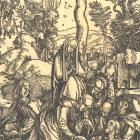The iconography of the Pietà is based on the Lamentation over the dead Christ, a theme not extensively narrated in the Gospels, but widely represented in view of its human and sentimental value.
From the fourteenth century, the group of people surrounding Jesus deposed from the Cross shrinks to only the figures of the mother and son, in a kind of dramatic counterpoint to the corresponding subject, namely the couple formed by the Virgin and the Child. The Pietà expresses the lonely desperation of Mary, who for the last time is holding her son on her knees, before consigning him to the grave. Dear to the heart of fourteenth century German Christian mysticism, the Pietà spreads throughout Italy via paintings and carved wooden groups of central European origin, giving rise in Michelangelo (Caprese, Arezzo, 1475 - Rome 1564) over a century later, to an impassioned meditation that would accompany him throughout the course of his life.








